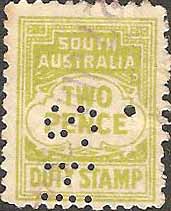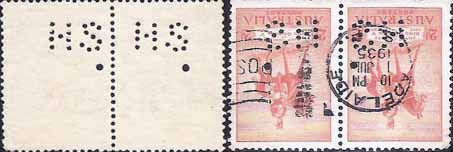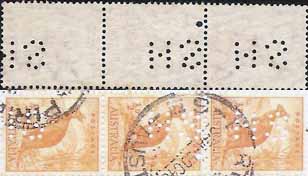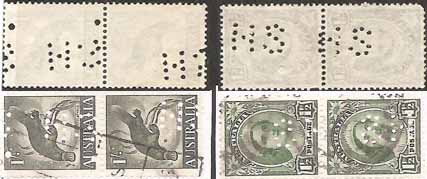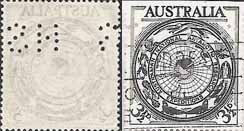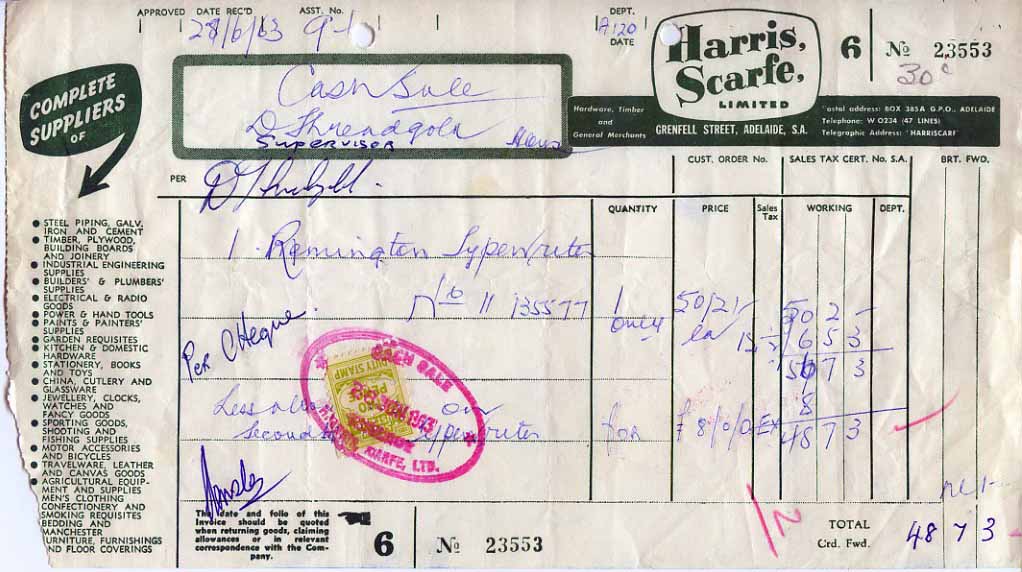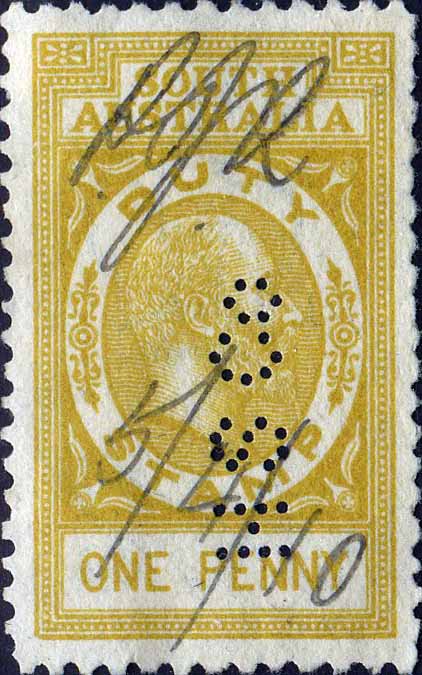|
Private Revenue Perfins of South Australia An Elsmore Coath production The authors would welcome your comments additions or input into this work H -------------------------------------------------------- HS/o.a
User: Harris Scarfe & Co Merchants, Ironmongers. Later Department Store Address: Gawler Place, Adelaide S.A. Grenfell St, Adelaide, S.A. Revenue Use: 1920 Series 1d, 2d. Rarity Scale: 1920 Series 1d R4, 2d R4. Railway Use: 1927 Series 1d, 6d. Rarity Scale: 1927 Series 1d R5, 6d R5. Background: *The company that became Harris Scarfe & Co began in Adelaide in 1849 when George Harris and John Lanyon arrived in Adelaide from England and formed a partnership as Lanyon & Harris (hardware and ironmongers). They opened their first premises in Hindley St, Adelaide but in 1855 Lanyon returned to England, leaving Harris as the sole owner and the business was renamed Geo. P. Harris. Subsequently Lanyon opened a buying office in London that serviced Geo. P Harris and other South Australian businesses. In 1857 (some sources say 1866) Harris took on new partners George Scarfe and Richard Smith and the company became Geo. P. Harris Scarfe & Co and this arrangement was formalised in July 1871. In 1877 the company purchased the Grenfell St address that it still occupies today, and here they offered a broad range of household, agricultural and industrial items. Harris returned to England in 1873 where he died on 26 November that year, aged 52. Scarfe continued on as chairman of the business until he passed away in April 1903, aged 76, but the company still carries their names today. The business continued to grow and in 1920 the company became Harris Scarfe Ltd. In addition to its Adelaide retail activities the company manufactured leather goods as well as conducting a large wholesaling operation, with a team of commercial travelers who visited country regions throughout South Australia. In 1971, Harris Scarfe Ltd was acquired by Baradeen Quest Pty Ltd a subsidiary of Investment and Merchant Finance Corporation Limited (IMFC). Later in 1976 IMFC was acquired by Charles Davis Ltd and this lead to a period of expansion with the Harris Scarfe Adelaide site becoming a Department Store and the hardware and industrial products sold through a subsidiary 'Harry’s,' which was located in Mile End. The success of Harry's led Harris Scarfe's parent company, Charles Davis Limited, to acquire other hardware retailers, including Lloyd's in South Australia, Campbell’s in Queensland, and McEwans in Victoria and New South Wales. In 1989, the hardware businesses were sold in a management buyout but Charles Davis Ltd through Harris Scarfe continued as a retail department store. During the 1990s Harris Scarfe began an era of unprecedented growth across Australia acquiring many sites from other retailers including David Jones, John Martins, Myer, Stirlings, and many of the sites formally used by the failed Venture retail chain. To this they added a merger with the Tasmanian department store chain FitzGeralds in 1995. At their peak Harris Scarfe operated 38 stores in all Australian States. In 2001, Harris Scarfe suffered cash flow problems and these could not be addressed and the company opted to enter voluntary receivership and its shares were withdrawn from the Australian Stock Exchange. Following this Harris Scarfe was sold to a private consortium with little money going to shareholders this consortium rationalised store locations and made modest growth while sales grew. They acquired the Allens department store chain (NSW/ACT) and from 2006 started to expand into new sites in South Australia and Victoria. Device: The HS/o.a pattern is produced by a two-die device in a horizontal array. The dies are essentially the same and so we list it as a single pattern. In some other studies of Australian Private Perfins the HS/o.a has been listed as two separate patterns due to the fact that the large hole under the 'S' is sometimes missing. This is not a reasonable way of cataloguing perfin patterns, as the absence of certain pins in a pattern is a normal occurrence. The two die HS/o..a device started out as part of a larger HS/&Co. device, which is only found on postage stamps. Initially there were two HS/&Co. devices, which were located in Perth, and Adelaide and these were both two-die devices in a horizontal array.
Perth device - Used 1908 until 1922 --
Adelaide device – Used 1907 until at least 1919
The patterns made from the dies across the two devices are very similar, but with comparisons of clear strikes you will note slight differences that will allow you to at least separate out the two remotely located devices. The main characteristic of the HS&Co. devices is the large pin that forms the main part of the 'O' of 'Co.'
In about 1920 (other studies state 1916, but we cannot find postmark evidence to support this earlier date, furthermore we have HS/&Co strikes used on issues that came out in 1919) the Adelaide device was altered with the removal of the &C.. Later in about 1922 the Perth device ceased to be used.
The change in the Adelaide device spawns a new pattern, HS.a. As can be seen from this pair of 1935 KGV Jubilees, the large pin that constituted the main part of the 'O' of 'Co' was retained in the two dies of the device.
It is notable that only the Adelaide device was altered in this way. All readable postmarks that we have seen on the HS.a, are from Adelaide or from other South Australian locations or Broken Hill, which is just across the SA border in NSW. Furthermore there are no reports of HS/o.a patterns on the revenue stamps of Western Australia.
In some strikes such as this one from the 1940’s, postmarked Port Pirie (SA), the large pin from the 'O' is missing on one of the dies. It is most often, but not always, the right hand die. This is not a permanent loss of a pin as the pin is present in later strikes.
Such as this one on the left from about 1960. The image on the right from the mid 1940’s shows a faint outline of the left hand large pin and no sign of the right hand large pin.
Furthermore there are times that the larger pin is not in evidence in the strike of either of the dies. Such as with the strikes of the two dies on this issue from 1954.
The HS/o.a pattern is produced by a two-die device that started as the HS/&Co. device located in Adelaide. The two dies of the HS device from Adelaide are essentially identical. In some strikes of the device either of the dies can be found with and without the larger pin that had previously formed part of the '&Co.' It is more often the right hand die, but it can be either and when viewing single strikes the left and right dies are not discernable.
The transient absence of pins in a pattern, for various reasons, is a feature of almost all perfin patterns and such 'missing pin' variations do not deserve listing as separate patterns.
Related patterns: Refer to other Harris Scarfe & Co patterns in: WA: HS/Co..a
*Harris Scarfe website
*TROVE
-------------------------------------------------------- HSCo.a
User: Howard Smith Co Ltd Shipping Agents Address: Gawler Place Adelaide S.A. & Port Adelaide. S.A. Revenue Use: 1904 Series 1d.
1906 1d. Rarity Scale: 1904
Series 1d R1. 1906 1d R1. Background: *Captain William Howard Smith arrived in Melbourne from Hull (Yorkshire) in 1854 and formed Howard Smith Limited and commenced regular voyages between Melbourne and Geelong. In 1864 he extended this to a Melbourne to Sydney passenger and cargo service and later included Newcastle (1868), then Maryborough, Adelaide, Brisbane and Rockhampton by 1880. This network was further extended to include Western Australia and Far North Queensland. Smith had established himself well in coal importation and trading and this and the growth in his passenger and general cargo services lead to the accumulation of a large fleet. In the late 1870s he had three of his sons in the partnership and they took charge of the Melbourne, Sydney and Brisbane offices. In 1883 the firm became a limited liability company, William Howard Smith and Sons Ltd. He was the managing director at Melbourne before he retired from active management in 1884 but he continued as chairman until 1887. Smith died in Melbourne in March 1890 aged 76, survived by his wife and seven sons and two daughters. The business was reorganized under the control of four sons, Edmund (Melbourne), Walter (Geelong), Harold (Sydney), and Ormond (Brisbane) In 1901 the company became Howard Smith Company Ltd in 1901 and later in 1914 it changed its name to Howard Smith Limited and it expanded from its base in the coastal shipping trade into the mining and sugar industries and later engineering, hardware, towage and safety. The shipping activities continued to grow until the late 1940’s when the company ceased their involvement in the passenger trade. In 1969 Howard Smith withdrew from the shipping business in and then in 2001 sold their towage interests. The company and its remaining hardware interests were absorbed by Wesfarmers Ltd., Perth, the owners of the Bunnings chain. At this time Howard Smith Ltd. was delisted from the Australian Stock Exchange. Device: Most likely a single die device this HSCO pattern is found on revenue and postage stamps with usage all across the Australia. The strikes found used in various locations are essentially identical so it is difficult to say if they were a series of identical dies in separate devices or a device located centrally (most likely the head office in Melbourne) which perforated stamps for dispatch to user areas. The central location would have faced the challenge of obtaining revenue and postage stamps of the various States and receiving these and returning them to user areas. More likely that the devices were a series of identical or near identical devices located at least in the main State office in each State. This argument for remote but similar devices is supported by the fact that company subsequently replaced the HSCO device(s) with a range of devices of similar appearance in the HSLD format and that these devices were allocated to their various offices around Australia. Related Patterns: refer to other Howard Smith patterns in: NSW: HSLD.a QLD: HSCO.a HSLD.a HSLD.b HSLD.c WA: HSCO.a *Australian Dictionary of Biography -------------------------------------------------------- © copyright 2011 |

